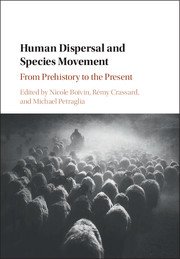Book contents
- Frontmatter
- Contents
- List of text boxes
- List of figures
- List of tables
- List of contributors
- Preface
- I Introduction
- II Origins: Species Movements in the Pleistocene
- III Across the water: Species movements by Coast and Sea
- IV Complexity: Species Movements in the Holocene
- V Invasion: The Movement of Invasive and Disease Species
- 15 Invasive eusocieties: Commonalities between ants and humans
- 16 Invasives, aliens, and labels long forgotten: Toward a semiotics of human-mediated species movement
- 17 Multiple time scales for dispersals of bacterial disease over human history
- 18 Early malarial infections and the first epidemiological transition
- 19 The globalisations of disease
- 20 Modern day population, pathogen and pest dispersals
- Index
- Plate section
- References
20 - Modern day population, pathogen and pest dispersals
from V - Invasion: The Movement of Invasive and Disease Species
Published online by Cambridge University Press: 04 May 2017
- Frontmatter
- Contents
- List of text boxes
- List of figures
- List of tables
- List of contributors
- Preface
- I Introduction
- II Origins: Species Movements in the Pleistocene
- III Across the water: Species movements by Coast and Sea
- IV Complexity: Species Movements in the Holocene
- V Invasion: The Movement of Invasive and Disease Species
- 15 Invasive eusocieties: Commonalities between ants and humans
- 16 Invasives, aliens, and labels long forgotten: Toward a semiotics of human-mediated species movement
- 17 Multiple time scales for dispersals of bacterial disease over human history
- 18 Early malarial infections and the first epidemiological transition
- 19 The globalisations of disease
- 20 Modern day population, pathogen and pest dispersals
- Index
- Plate section
- References
Summary
Abstract
The anthropogenic translocation of species has been a constant occurrence throughout human history, resulting in the exchange of pathogens and pests. However, only in the last few decades has extensive and regular contact between peoples, flora and fauna from both the Old and New Worlds occurred. The recent increases in speed, reach and volume of modern transport is putting people at risk from the emergence of new strains of familiar diseases on the other side of the planet, and from completely new diseases, while rates of dispersal of both disease vectors and the diseases they carry are increasing. Moreover, this growing global connectivity is increasing the rates of invasive ‘pest’ species arrivals. This chapter describes these modern-day trends and presents case studies that illustrate the effects of growing international connectivity across spatial scales, and how novel digital datasets are increasingly available to help us understand and control some of the negative effects of these dispersals.
Keywords: Invasive species, air travel, shipping, disease dispersal, human mobility
MODERN TRENDS IN HUMAN MOBILITY
Human movement is a critical behavioural factor underlying observed patterns of disease transmission and pest and pathogen dispersals. Patterns of contact between infectious agents and susceptible hosts can amplify or dampen rates of transmission, and different types of movements across spatial and temporal scales (Figure 20.1) can have varying relevance to public health (Prothero 1977; Stoddard et al. 2009). Moreover, as has been the case throughout history, and as is emphasised throughout this book, the movement of humans can also result in the dispersal of pathogens and pests through accidental or purposeful carriage (see in particular chapters by Achtman, Green and Webb in this volume).
While the dispersal of humans and their pathogens and pest species has been an ongoing phenomena for thousands of years, the speed and frequency of dispersal events have grown exponentially over recent decades (Cliff and Haggett 2004; Tatem et al. 2006b). The principal driver behind such changes has been the rapid development of long-distance and high-speed transport as a product of today's globalised society. Land-based transport in the form of cars, buses and railways has become affordable to almost all, with networks becoming more efficient and wider-reaching than ever before.
- Type
- Chapter
- Information
- Human Dispersal and Species MovementFrom Prehistory to the Present, pp. 521 - 534Publisher: Cambridge University PressPrint publication year: 2017
References
- 1
- Cited by



